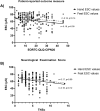Association of electrochemical skin conductance with neuropathy in chemotherapy-treated patients
- PMID: 36129622
- PMCID: PMC9719444
- DOI: 10.1007/s10286-022-00895-w
Association of electrochemical skin conductance with neuropathy in chemotherapy-treated patients
Abstract
Purpose: Chemotherapy-induced peripheral neuropathy (CIPN) is an adverse event of cancer treatment that can affect sensory, motor, or autonomic nerves. Assessment of autonomic neuropathy is challenging, with limited available tools. Accordingly, it is not routinely assessed in chemotherapy-treated patients. In this study, we aimed to examine whether electrochemical skin conductance (ESC) via Sudoscan, a potential measure of autonomic function, associates with subjective and objective measures of CIPN severity and autonomic neuropathy.
Methods: A cross-sectional assessment of patients who completed neurotoxic chemotherapy 3-24 months prior was undertaken using CIPN patient-reported outcomes (EORTC-QLQ-CIPN20), clinically graded scale (NCI-CTCAE), neurological examination score (TNSc), autonomic outcome measure (SAS), and Sudoscan. Differences in CIPN severity between participants with or without ESC dysfunction were investigated. Linear regression analyses were used to identify whether ESC values could predict CIPN severity.
Results: A total of 130 participants were assessed, with 93 participants classified with CIPN according to the clinically graded scale (NCI-CTCAE/grade ≥ 1), while 49% demonstrated hands or feet ESC dysfunction (n = 46). Participants with ESC dysfunction did not significantly differ from those with no dysfunction on multiple CIPN severity measures (clinical-grade, patient-report, neurological examination), and no differences on the autonomic outcome measure (SAS) (all p > 0.0063). Linear regression analyses showed that CIPN could not be predicted by ESC values.
Conclusions: The inability of ESC values via Sudoscan to predict clinically-graded and patient-reported CIPN or autonomic dysfunction questions its clinical utility for chemotherapy-treated patients. The understanding of autonomic neuropathy with chemotherapy treatment remains limited and must be addressed to improve quality of life in cancer survivors.
Keywords: Autonomic; Chemotherapy-induced peripheral neuropathy (CIPN); Electrochemical skin conductance (ESC); Sudomotor; Sudoscan.
© 2022. The Author(s).
Conflict of interest statement
The authors have no relevant financial or non-financial interests to disclose.
Figures
Similar articles
-
Repurposing chemotherapy-induced peripheral neuropathy grading.Eur J Neurol. 2024 Dec;31(12):e16457. doi: 10.1111/ene.16457. Epub 2024 Sep 16. Eur J Neurol. 2024. PMID: 39282967 Free PMC article.
-
Patient-Reported Outcome Measures in Chemotherapy-Induced Peripheral Neurotoxicity: Defining Minimal and Clinically Important Changes.J Natl Compr Canc Netw. 2023 Feb;21(2):125-132.e3. doi: 10.6004/jnccn.2022.7074. J Natl Compr Canc Netw. 2023. PMID: 36791763
-
Validity of Patient-Reported Outcome Measures in Evaluating Nerve Damage Following Chemotherapy.JAMA Netw Open. 2024 Aug 1;7(8):e2424139. doi: 10.1001/jamanetworkopen.2024.24139. JAMA Netw Open. 2024. PMID: 39120903 Free PMC article.
-
Sudomotor function testing by electrochemical skin conductance: does it really measure sudomotor function?Clin Auton Res. 2019 Feb;29(1):31-39. doi: 10.1007/s10286-018-0540-0. Epub 2018 Jun 28. Clin Auton Res. 2019. PMID: 29956008
-
[Chemotherapy-induced peripheral neuropathy; impact on quality of life].Ned Tijdschr Geneeskd. 2014;158:A7455. Ned Tijdschr Geneeskd. 2014. PMID: 25315326 Review. Dutch.
References
Publication types
MeSH terms
Substances
LinkOut - more resources
Full Text Sources
Medical


